Testing & Methodology

We’ve expanded our testing suite considerably since the X79 chipset release, and will continue to use the same methods for most of the motherboards and CPU’s we test. In the interests of thoroughness and accurate results, we run each test at least three times, and some tests more than that. We average the total of all the tests from each benchmark then report the average here.
The OS we use is Windows 7 Pro 64bit with all patches and updates applied. We also use the latest drivers available for the motherboard and any devices attached to the computer. We do not disable background tasks or tweak the OS or system in any way. We turn off drive indexing and daily defragging. We also turn off Prefetch and Superfetch. This is not an attempt to produce bigger benchmark numbers. Drive indexing and defragging can interfere with testing and produce confusing numbers. If a test were to be run while a drive was being indexed or defragged, and then the same test was later run when these processes were off, the two results would be contradictory and erroneous. As we cannot control when defragging and indexing occur precisely enough to guarantee that they won’t interfere with testing, we opt to disable the features entirely.
Prefetch tries to predict what users will load the next time they boot the machine by caching the relevant files and storing them for later use. We want to learn how the program runs without any of the files being cached, and we disable it so that each test run we do not have to clear pre-fetch to get accurate numbers. Lastly we disable Superfetch. Superfetch loads often-used programs into the memory. It is one of the reasons that Windows occupies so much memory. Vista fills the memory in an attempt to predict what users will load. Having one test run with files cached, and another test run with the files un-cached would result in inaccurate numbers. Again, since we can’t control its timings so precisely, it we turn it off. Because these four features can potentially interfere with benchmarking, and and are out of our control, we disable them. We do not disable anything else.
One thing to note is that we are revamping our testing method in order to better represent motherboard performance and offering to you guys the consumer. Also we want to make it an easier read for you without miles of endless charts. Please feel free to provide feedback on what you think as many benchmarks will be shuffled or removed completely.
Test Rig
| Test Rig | |
| Case | Thermaltake Level 10 GT |
| CPU | Intel Core i7-4770K |
| Motherboard | ASUS Maximus VI Extreme |
| Ram | Gskill TridentX 2666MHz |
| CPU Cooler | Swiftech H20-220 Edge |
| Hard Drive | Western DIGItal Velociraptor 300GB |
| SSD | Intel 510 series SATA III 120GB |
| Optical | ASUS BD-ROM |
| GPU | ASUS GTX680 Top |
| Additional Cards | N/A |
| PSU | Thermaltake Toughpower XT 1275W Platinum |
| Mouse | Tt eSPORTS Black gaming mouse |
| Keyboard | Tt eSPORTS Meka G1 mechanical gaming keyboard |
Test Suite
We will use the following applications to test the performance of the Motherboard
| Benchmarks |
|---|
| SuperPi Mod 1.5 |
| Wprime 1.55 |
| PCMark 7 |
| 3DMark 11 |
| Cinebench R11.5 |
| SiSoft Sandra 2013 |
| X264HD |
| Truecrypt 7.1 |
| Unigine Heaven 4.0 |
| Metro 2033 |
| Batman Arkham City |
| Sniper Elite V2 |
Overclocking

The Z87 Platform is a totally different animal in terms of overclocking here. The Haswell Processor (4770K in this case) can run very hot when clocking which means you gotta have some good cooling if your pushing the limits. Luckily for us, we have access to everything up to LN2 to test with but in reality as most users reading this will never venture that far past liquid cooling we try to keep it rather pedestrian in comparison with a custom 240mm radiator liquid cooling setup. It has worked very well with SB, SB-E, IVB and so on, but we must say Haswell definitely put it to the test.
Raising the multiplier is your quickest way to overclock the CPU which with some small voltage tweaks we were able to get to my testing speed of 4.6GHz and with not a huge amount of voltage but it should be noted that even at 4.6 which we consider to be a modestly high overclock for 24/7 usage it definitely runs much hotter than Ivy Bridge (3770K) and mind you that is to no fault of the board but more so to the design of the CPU itself in which you get the extra thermal dump.
The auto overclocking for the ASUS board was very interesting as it had a strict hard set limit of 1.275Vcore to ensure that it would not overwhelm the majority of coolers on the market and we have to respect that as they did the research to find where the tipping point is in terms of high performance cooling and overclocking. When it comes down to it, we know we will give less buffer and therefore maintain much more speed with the same voltage so we pushed it ourselves.
We are very happy with this chip as we have many and this one with the Intel board would hold 4.6GHz through any test 100% stable at 1.22V so we were very happy to see that on the Maximus VI Extreme it was able to maintain the same level of stability at the same clocks with just 1.20V dead on. There is much more in this platform but its gonna take some much better cooling to show how far the chip can really go here.
It is worth noting that with auto settings and just Vcore adjustment would allow a 4.6GHz clock and basically took a whole 30 seconds to get there. We could go through and tweak down much more to save slightly more heat but you get the idea, this board really does make clocking quite easy, and with all the features it should follow suit with previous Maximus boards allowing a better run on extreme benching as well.
Important note: Overclocking can cause component failure. Please exercise caution when attempting any level of overclock on system components.
Temperatures

The temperatures were recorded with RealTemp while running wPrime 1024 right before the end of the 5th run. The results were recorded carefully. After the results were recorded, we waited for 30 minutes before taking Idle temperature measurements. The results were as follows:
| CPU Temperatures | Temperature (Idle/Load) |
| ASUS Maximus VI Extreme OC (4.6GHz) | 34C/72C |
| ASUS Maximus VI Extreme | 30C/61C |
| Chipset Temperatures | Temperature (Idle/Load) |
| ASUS Maximus VI Extreme OC (4.6GHz) | 34C/41C |
| ASUS Maximus VI Extreme | 31C/36C |
The reason temps may look a little lower than seen elsewhere online is that We are using a custom liquid cooling loop compliments of Swiftech which helps us reach an area of much higher headroom for overclocking and performance testing.
Power Consumption

The power consumption was tested while running Wprime 1024 for a few minutes at stock settings. The results were recorded carefully with a Kill-A-Watt power consumption measuring tool at the wall. After the results were recorded, we waited for yet another few minutes minutes before taking Idle power consumption measurements.
The power consumption is measured without a GPU installed but the iGPU loaded to see what the best representation of peak power consumption you can expect. Do note that this board pulls a bit more than the Intel reference board but then again this board has a whole lot more features and stuff to power so it really makes sense.
Performance Benchmarks
PCmark 7

Here with PCMark 7 you can see that the Maximus gives us a nice jump over the reference Intel board which doesnt surprise me as most board partners offerings tend to take the reference board and give it a nice kick of efficiency.
3DMark 11

iGPU
Discrete GPU
Here you can see that overall the Maximus VI Extreme really does a pretty good job not only beating Z77 but beating the Intel reference board as this board is simply setup a bit more for performance rather than the Intel board which is tuned for box stock reliability.
SuperPi
The Maximus board seems to do decently here but is a bit behind the Intel board but once again being the fact that we have been getting BIOS updates regularly all the way up to the launch and then even after a bit we will reserve our opinion on the single threaded performance until I feel that everything including MRC updates are under control. These updates included updated code from Intel so its possible that it could change the state of the game completely in a single update.
Wprime
WPrime is similar to Superpi, but is multi core aware and you can set the core count. We used 8 cores to take advantage of the 4770K’s HyperThreading ability. Here the Maximus takes charge and really knocks out a good score at default but at overclock sightly leads the Intel board, and we have found that the Intel board has some strange tuning and results in memory and we believe this may be causing the strange results we see.
Cinebench R11.5

“CINEBENCH is a real-world test suite that assesses your computer’s performance capabilities. MAXON CINEBENCH is based on MAXON’s award-winning animation software, CINEMA 4D, which is used extensively by studios and production houses worldwide for 3D content creation. MAXON software has been used in blockbuster movies such as Spider-Man, Star Wars, The Chronicles of Narnia and many more. MAXON CINEBENCH runs several tests on your computer to measure the performance of the main processor and the graphics card under real world circumstances. The benchmark application makes use of up to 16 CPUs or CPU cores and is available for Windows (32-bit and 64-Bit) and Macintosh (PPC and Intel-based). The resulting values among different operating systems are 100% comparable and therefore very useful with regard to purchasing decision-making. It can also be used as a marketing tool for hardware vendors or simply to compare hardware among colleagues or friends.”
SiSoft Sandra 2013

“SiSoftware Sandra (the System Analyzer, Diagnostic and Reporting Assistant) is an information & diagnostic utility. It should provide most of the information (including undocumented) you need to know about your hardware, software and other devices whether hardware or software. It works along the lines of other Windows utilities, however it tries to go beyond them and show you more of what’s really going on. Giving the user the ability to draw comparisons at both a high and low-level. You can get information about the CPU, chipset, video adapter, ports, printers, sound card, memory, network, Windows internals, AGP, PCI, PCI-X, PCIe (PCI Express), database, USB, USB2, 1394/Firewire, etc.”
Click Images to Enlarge
Here with Sandra testing, you can see there is some give and take here. One area that surprised us was the AES encyption, which makes an absolutely huge leap going from Z77 to Z87.
Another interesting area we have seen has to do with the memory bandwidth. On the Intel board, a dual channel bandwidth can go into the 32GB/s range, whereas the competition is around 26-28GB/s. While this may not seem like much, that really is a very huge pipeline for data. Testing another Z87 model from two different manufacturers now reveals that the Intel board is the only one capable of pulling such a feat, which means they definitely have some special tweaks going on making for some very impressive memory capabilities. That being noted I do wonder if such aggressive tuning on Intel’s part will mean possible memory compatibility issues compared to the other board partners who may run slightly less aggressive board level tuning in order to maximize memory compatibility.
X264HD

Transcoding has become more popular now and the latest Sandy Bridge processor added support for AVX instruction for faster video transcoding. With that you can see that going from Ivy Bridge to Haswell can net you some very good gains, especially a 2FPS gain on 2 Pass. This tells us that overall optimizations to the new platform are present and working very well.
Truecrypt 7.1

TrueCrypt is a real world application that gives a good indication of the true performance of our latest processor. Here the new Core i7 4770K puts some definite room between itself and the outgoing 3770K with over a 22% performance increase, which means in the same time you can get a lot more work done.
Unigine Heaven 4.0

Unigine Heaven is a benchmark program based on Unigine Corp’s latest engine, Unigine. The engine features DirectX 11, Hardware tessellation, DirectCompute, and Shader Model 5.0. All of these new technologies combined with the ability to run each card through the same exact test means this benchmark should be in our arsenal for a long time.
iGPU
The iGPU is not ideal for a 3D-heavy load like the Heaven benchmark. Nonetheless, to see a three FPS gain is quite huge for an integrated unit and tells us that with the right settings, the HD4600 could easily be used for gaming. This definitely lives up to what Intel is trying to accomplish, which is to make a solution that literally covers all of the bases in one shot.
Discrete GPU
Unigine Heaven on a discrete GTX 680 gains about a single FPS, probably just due to the expanded performance with the overclock. For the most part, however, recent platforms are so efficient that there simply is no bottleneck for current gen card models.
Metro 2033

Once again, Metro 2033 shows that discrete GPU performance is relatively unaffected, simply due to the fact that there is already so much unused bandwidth available.
Batman Arkham City
iGPU
Batman Arkham City is a very pretty game with nice visuals and very cool overall effects. With good settings but no AA, we tested it on the iGPUs, and the minimum framerates are much higher. The iGPU also yields an average of over 30FPS which means the game would be rather playable, albeit with some occasional choppiness possible.
Discrete GPU
Discrete GPU results once again hover without huge movement as the bandwidth is unsaturated for PCIe 3.0.
Sniper Elite V2
iGPU
Once again the HD4600 impresses with a nice gain, although the detail on Sniper Elite V2 is simply a bit too much for the iGPU to handle at playable framerates.
Discrete GPU
The overall trend here is the same as for the other discrete GPU results, though the addition of the Maximus board yields a bit higher minimum framerate due to the performance optimizations.
CONCLUSION
The Maximus VI Extreme is the Flagship Z87 board from ASUS and we can see why, it is simply packed to the gills with features, then just to add more there is the breakout OC Panel which adds even more capability. Whats great about this is that this time around ASUS was able to bring the board to standard ATX form factor to allow better universal fitment among chassis as some of the features were moved to the remote OC Panel.
ASUS has always used the ROG line to introduce some of its newest innovations and to test them on the extreme community as they are most likely to use some of these cutting edge features. Many things from the ROG series trickle down to the more mainstream line of boards as they are perfected on the ROG series, but things such as the ROG OCKey was nice, but converting to something that mimics a K type thermometer but has many more features while supporting two thermal probes is awesome.
4 Way SLI compatibility, ROG RAMDisk, SSD Secure Erase, WifiAC included along with so many other overclocking features this board is just a big can of kick ass waiting to be unleashed.
This does not come without its cons. The price is definitely on the steep side for a mainstream board, and we wish ASUS would offer a lighter version of the Extreme with 4 Way SLI support but no bundled OCPanel for those who want to use this in an extreme gaming system but don’t need the extra included device. We believe that could possible make it a bit more competitive to make the OC Panel an option.
Overall we need to look at this board for what it is, as we know there are many ROG boards here or coming such as the Hero for extreme gamers, Formula for your in between of Extreme and Hero and even the Impact for your extreme ITX offering. All in all the Extreme was always about being the best of the best, regardless of cost. That’s what you get here, although the cost may still be a bit too much for many to swallow as there are other OC related boards that sell for quite a bit less.
| OUR VERDICT: Maximus VI Extreme | ||||||||||||||||||
|
||||||||||||||||||
| Summary: The Maximus VI Extreme is a very interesting board with plenty of performance potential just waiting for a good chip and sticks and the right user to push it up and beyond. For that it earns the Bjorn3D Golden Bear Award. |
 Bjorn3D.com Bjorn3d.com – Satisfying Your Daily Tech Cravings Since 1996
Bjorn3D.com Bjorn3d.com – Satisfying Your Daily Tech Cravings Since 1996
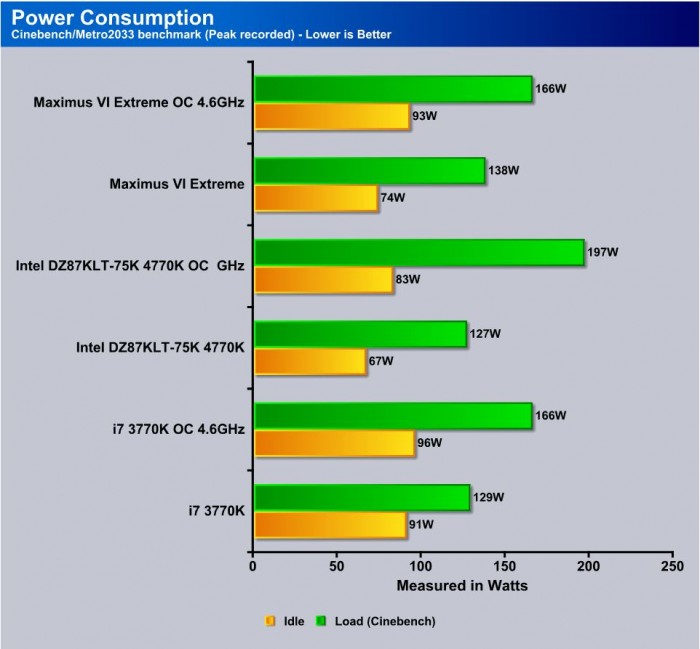
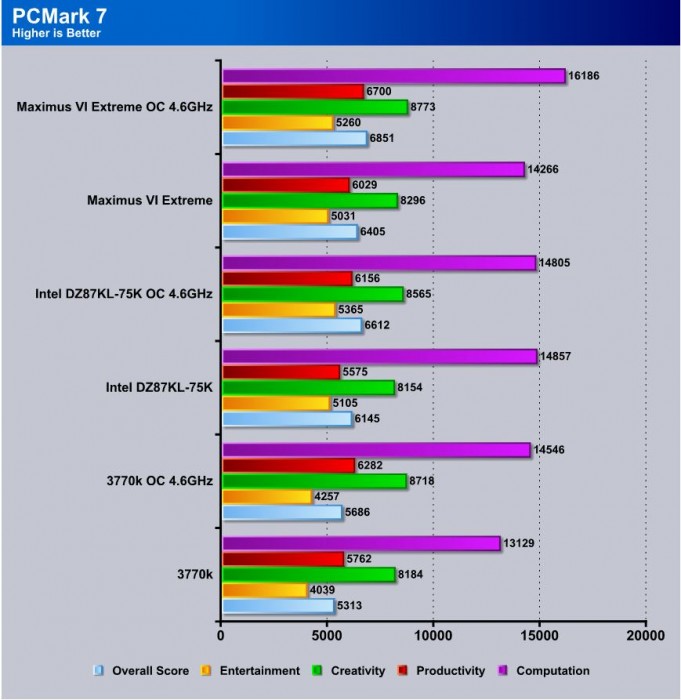



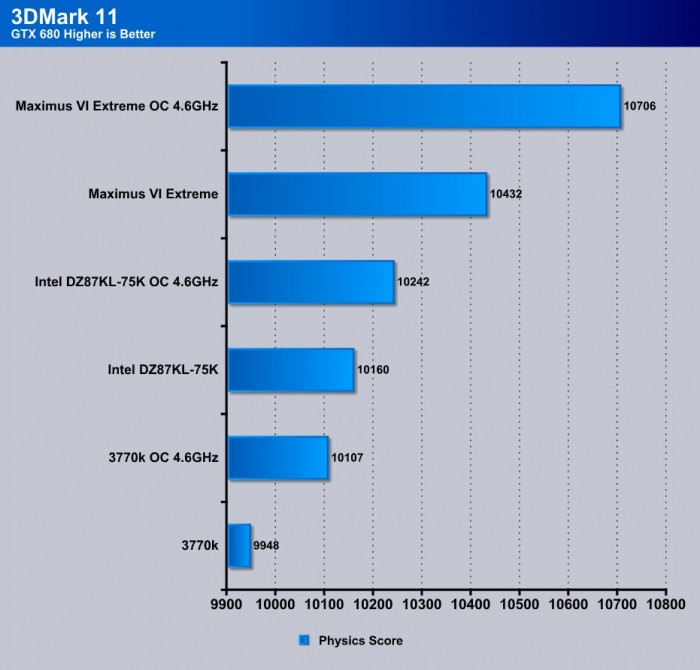
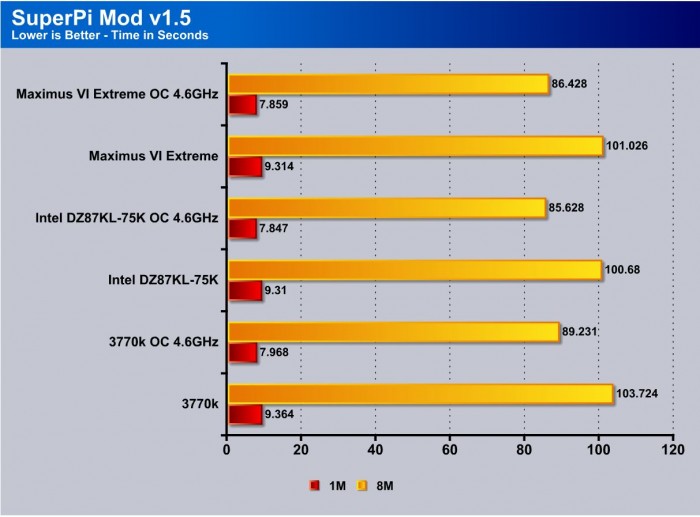
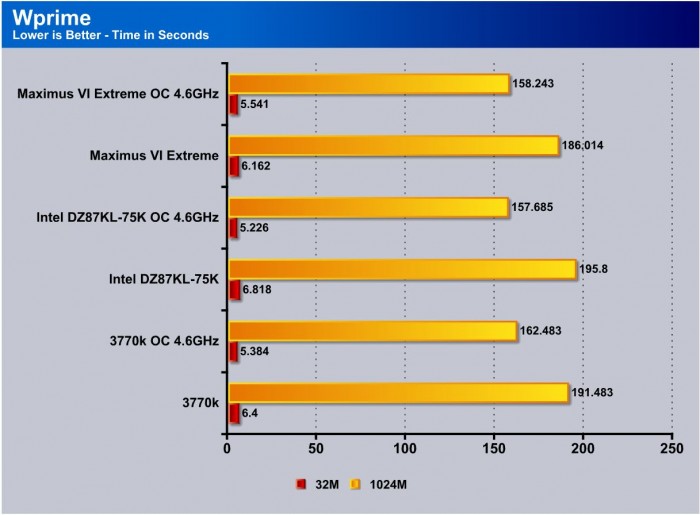

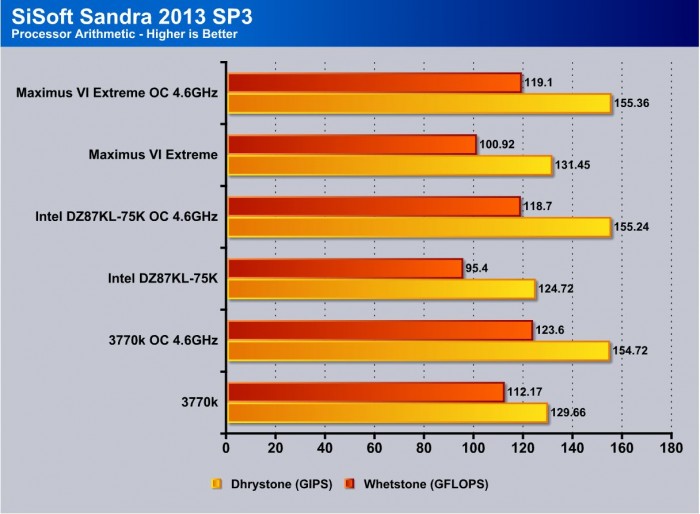
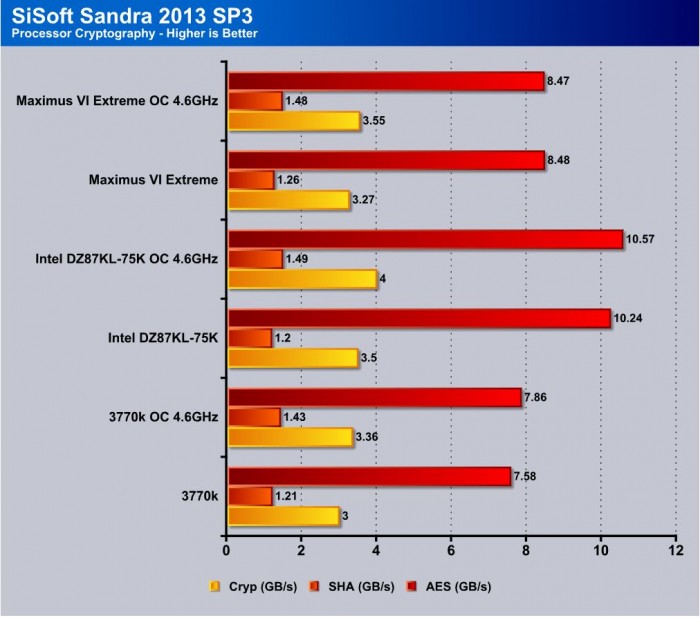
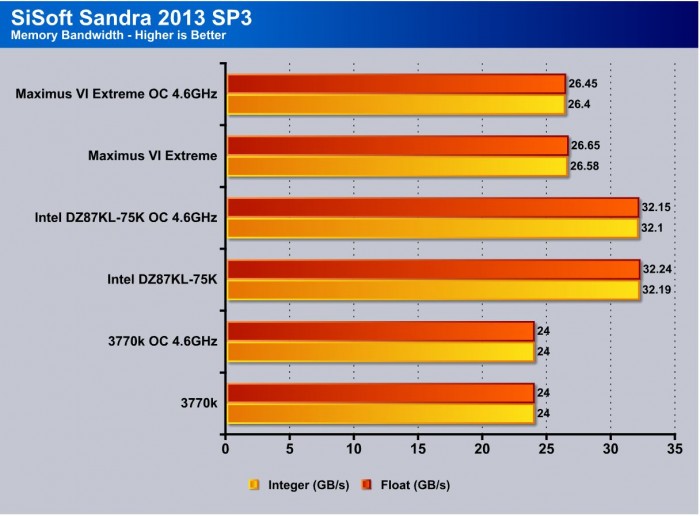
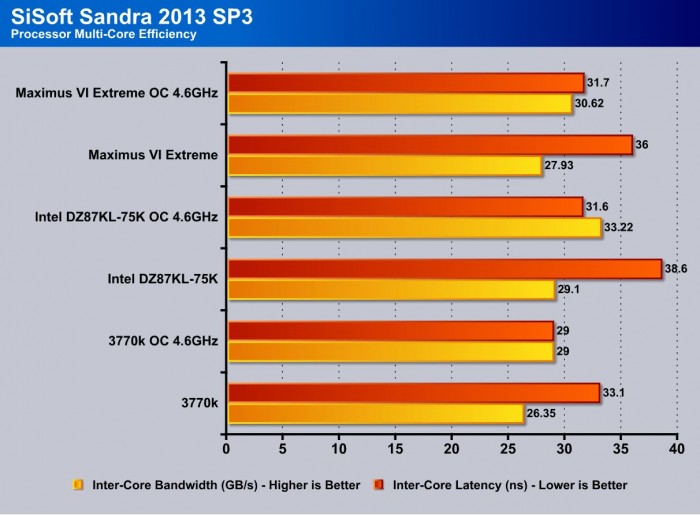
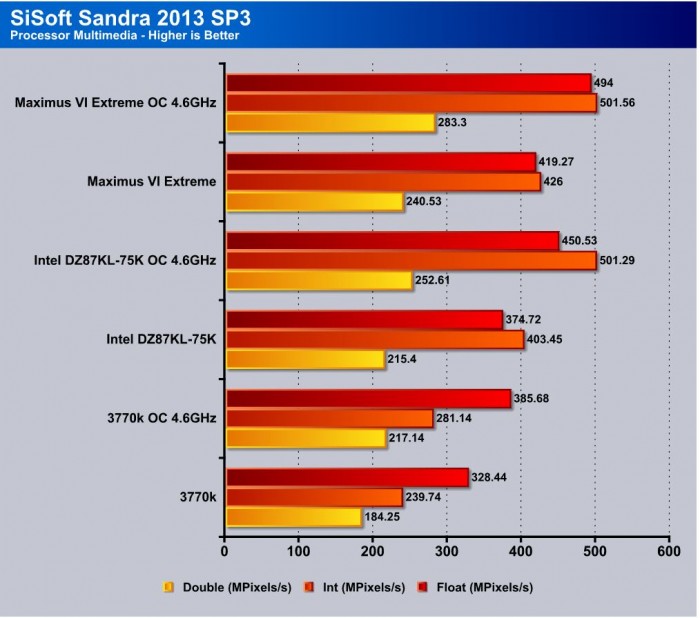
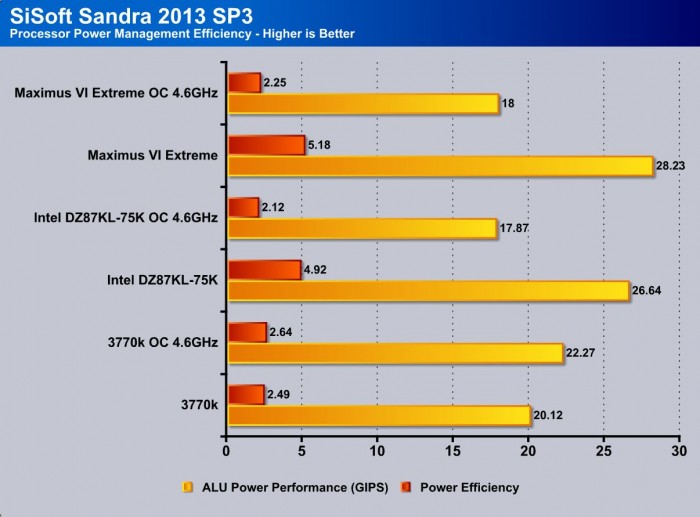

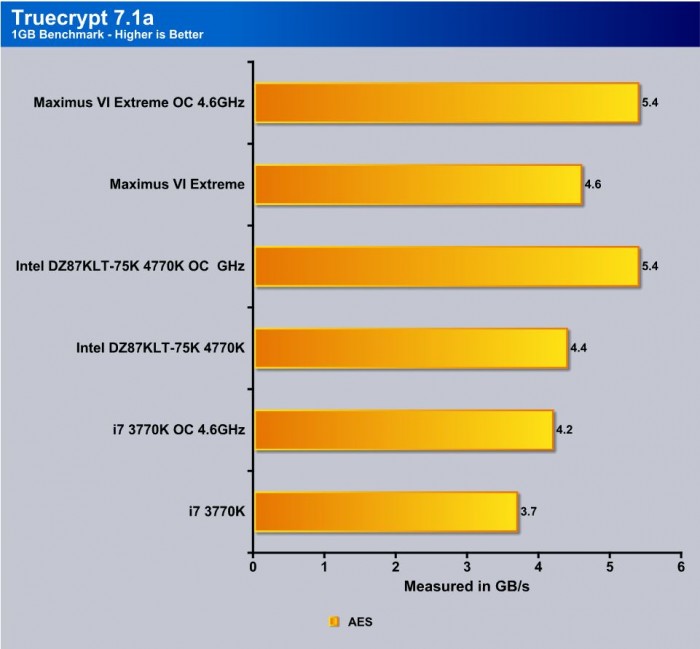
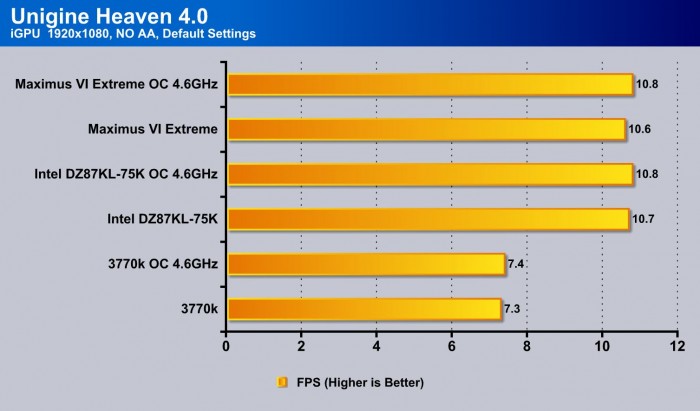

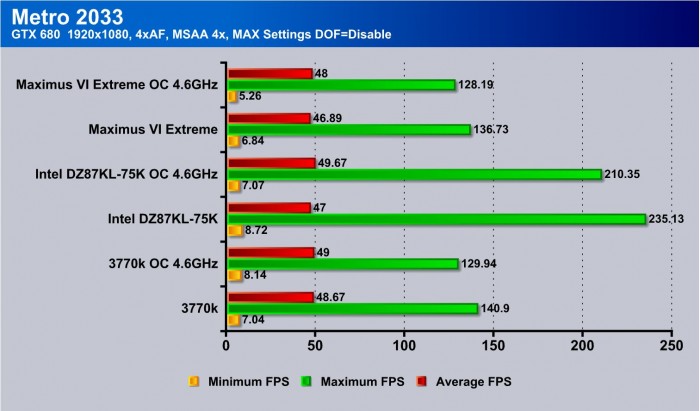



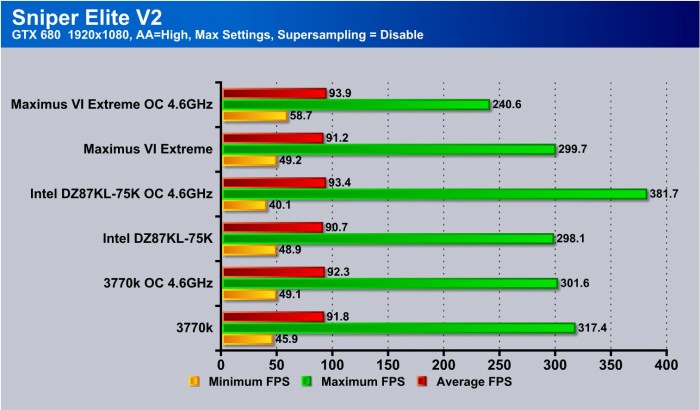









I own this motherboard, and I too had thoughts about wanting the top-middle-bottom PCIe slots to be useable at the same time for 3-way SLI configuration air cooling.
Although this isn’t possible, what I did discover is that this motherboard has thermal sensor capability on the optional fan headers. If you have the right case and cards (non-reference) these thermal headers work great with a high speed fan to cool a sandwiched 3-way SLI rig. This was a big relief as I really didn’t want to implement liquid cooling for the video cards, and use Corsair H80i for my Haswell i7-4770k. I use stock speeds on my GPU’s and CPU. My hottest card hits 74C with ambient temp around 74F while gaming.
Without the thermal control there’s no good way to use a fan that can properly cool a 3-way SLI configuration. You need it to be variable so it’s not too loud when not gaming, and you need a high speed 120mm fan (4000rpm) to have enough airflow to cool it under load.
At Idle it’ll run around 2000rpm and be relatively quiet and ramp up to 3700rpm and be about as loud as a reference style blower graphics card (not quite). In the BIOS, setting is 50%-90% for the variable fan speed range and based on temp range of 35c-60c. The temps being measured at the GPU heat sink fins by the ASUS thermal wire. After testing I determined the 35c-60c temp range setting for controlling the fan speed and relative GPU temps under load. It keeps the GPU’s at 33c at 2000rpm up to 74c at 3800rpm and temps measured by ASUS’s GPUTweak.
I have 3 GTX680-DC2-4GD5 on my MVIE.
Great mobo!